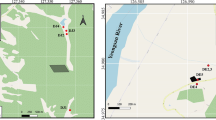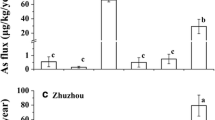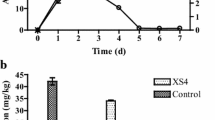Abstract
Arsenic (As) contamination has become the environment issue of global concern. In China, large area of farmland and the site soil were contaminated by As, which means that suitable remedying methods were urgently needed. Phytoremediation, as one of environment-friendly soil remediation techniques developed in recent years, shows a bright future for the remediation of As contaminated soils. However, phytoremediation efficiency needs to be enhanced further because of low concentration of bio-available As in the soils. A triangle flask culture experiment was carried out to study the effects of functional species, isolated from As-polluted soils, that could improve As mobility from the soil. These species included two bacilli, B1 and B2 (Brevibacillus) and two fungi, F1 (Trichoderma), F2 (Fusarium). They could transform the concentration of As fractionation in the soil sterilized by the method of 60Co-γ ray. Through the experiment, the concentrations of non-specifically-sorbed and specifically-sorbed As fractionation, and pH value of culture solution with inoculated treatment were higher than that with the control. Especially, the concentration of non-specifically-sorbed As fractionation in the treatment-inoculated species was 2 to 6 times higher than that of non-inoculation treatment. Moreover, two bacilli and two fungi could produce IAA, which was conducive to the plant survival when they were jointly used in remedying the As-contaminated soil.
Similar content being viewed by others
References
Belimov A A, Hontzeas N, Safronova V I, et al. 2005. Cadmium-tolerant plant growth-promoting bacteria associated with the roots of Indian mustard (Brassica juncea L. Czern.). Soil Biol Biochem, 37: 241–250
Brows M E. 1972. Plant growth substances produced by micro-organisms of soil and rhizosphere. J Appl Bacteriol, 35: 443–451
Burd G I, Dixon D G, Glick B R. 1998. A plant growth-promoting bacterium that decreases nickel toxicity in seedlings. Appl Environ Microbiol, 64: 3663–3668
Burd G I, Dixon D G, Glick B R. 2000. Plant growth-promoting bacteria that decrease heavy metal toxicity in plants. Can J Microbiol, 46: 237–245
Cantafio A W, Hagen K D, Lewis G E. 1996. Pilot-scale selenium bioremediation of San Joaquin drainage water with Thauera selenatis. Appl Environ Microbiol, 62: 3298–3303
Dong X Z, Cai M F. 2001. The Manual of Bacterial Identification (in Chinese). Beijing: Science Press. 43–65
The Department of Microbiology, Institute of Soil Science, Chinese Academy of Sciences. 1985. Experimental Methods of Soil Microbial (in Chinese). Beijing: Science Press. 40–59
Egamberdiyeva D, Hflich G. 2004. Effect of plant growth-promoting bacteria on growth and nutrient uptake of cotton and pea in a semiarid region of Uzbekistan. J Arid Environ, 56: 293–301
Francis A J, Dodge C J. 1988. Anaerobic microbial dissolution of transition and heavy metal oxdides. Appl Environ Microbiol, 54: 1009–1014
Gadd G M. 1999. Fungal production of citric and oxalic acid: Importance in metal physiology and biogeochemical processes. Adv Microb Physiol, 41: 47–92
Gihring T M, Druschel G K, Mccleskey R B, et al. 2001. Rapid arsenite oxidation by Thermus aquaTicus and Thermus thermophilus: Field and laboratory investigations. Environ Sci Technol, 35: 3857–3862
Grichko V P, Filby B, Glick B R. 2000. Increased ability of transgenic plants expressing the bacterial enzyme ACC deaminase to accumulate Cd, Co, Cu, Ni, Pb and Zn. J Biotechnol, 81: 45–53
Hudson-Edwards K A, Houghton S L, Osborn A. 2004. Extraction and analysis of arsenic in soils and sediments. Trac-Trend Anal Chem, 23: 745–752
Idris R, Trifonova R, Puschenreiter M, et al. 2004. Bacterial communities associated with flowering plants of the Ni hyperaccumulator Thlaspi goesingense. Appl Environ Microbiol, 70: 2667–2677
Kalinowski B E, Liermann L J, Brantley S L. 2000. X-ray photoelectron evidence for bacteriaenhanced dissolution of hornblende. Geochim Cosmochim Acta, 107: 225–231
Keon N E, Swartz H, Bradbander D J, et al. 2001. Validation of an arsenic sequential extraction method for evaluating mobility in sediments. Environ Sci Technol, 35: 2778–2784
Li Y, Yu L, Li H X, et al. 2012. Isolation, identification and characteristics of a peanut growth-promotion strain of rhizobacteria (in Chinese). J Ecol Rural Environ, 28: 416–421
Ma J, Han Y H, Zhou X Y, et al. 2012. Effect of different extraction methods on arsenic speciation extraction in soil and Pteris vittata L (in Chinese). M Instrum, 18: 16–19
Meharg A A, Hartley-Whitaker J. 2002. Arsenic uptake and metabolism in arsenic resistant and nonresistant plant species. New Phytol, 154: 29–43
Nies L, Shah S, Rashid A, et al. 2002. Phytoremediation of arsenate contaminated soil by transgenic canola and the plant growth-promoting bacterium Enterobacter cloacae CAL2. Plant Physiol Bioch, 40: 355–361
Pan R Z. 2003. Plant Physiology. 4th ed. (in Chinese). Beijing: High Education Press. 33–42
Rhine D E, Garcia-Dominguez E, Phelps C, et al. 2005. Environmental microbes can speciate and cycle arsenic. Environ Sci Technol, 39: 9569–9573
Rutherford D W, Bednar A J, Garbarino J R, et al. 2003. Environmental fate of roxarsone in poultry, part II. mobility of arsenic in soils amended with poultry litter. Environ Sci Technol, 37: 1515–1520
Van H S, Swennen R, Vandecasteele C, et al. 2003. Solid phase speciation of arsenic by sequential extraction in standard reference materials and industrially contaminated soil samples. Environ Pollut, 122: 323–342
Vivas A, Biró B, Ruíz-Lozano J M, et al. 2006. Two bacterial strains isolated from a Zn-polluted soil enhance plant growth and mycorrhizal efficiency under Zn-toxicity. Chemosphere, 62: 1523–1533
Wei J C. 1979. The Manual of Fungal Identification (in Chinese). Shanghai: Shanghai Science and Technology Press. 493–494, 609–615
Wenzel W W, Kirchbaumer N, Prohaska T, et al. 2001. Arsenic fractionation in soils using an improved sequential extraction procedure. Anal Chim Acta, 436: 309–323
Wenzel W W, Brandstetter A, Wutte H, et al. 2002. Arsenic in fieldcollected soil solutions and extracts of contaminated soils and its implication to soil standards. J Plant Nutr Soil Sci, 165: 221–228
Yang J K, Barnett M O, Jardine P M, et al. 2002. Adsorption, sequestration, and bioaccessibility of As (V) in soils. Environ Sci Technol, 36: 4562–4569
Zhao G C, Liao X Y, Yan X L, et al. 2010. Enhancement of As-accumulation by Pteris vittata L. affected by microorganisms (in Chinese). Environ Sci, 31: 431–436
Author information
Authors and Affiliations
Corresponding author
Rights and permissions
About this article
Cite this article
Bai, J., Lin, X., Dai, J. et al. Improving arsenic mobility concentration from As-polluted soils by the functional strains. Sci. China Earth Sci. 58, 1420–1426 (2015). https://doi.org/10.1007/s11430-015-5065-y
Received:
Accepted:
Published:
Issue Date:
DOI: https://doi.org/10.1007/s11430-015-5065-y




